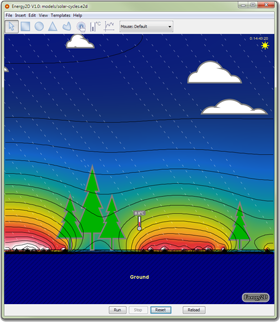Install the Energy2D App
Windows (Vista/7/8/10), Mac OS X (10.7.3 or higher) users, and Raspberry Pi users can install the Energy2D app using the installers — Java installation is no longer required to run the app on those two operating systems. Users of Linux, old Windows (2000/XP), or old Mac OS X (lower than 10.7.3) still must install Java before installing the Energy2D app and must use the JNLP Installer (i.e., the Linux Installer). The Zip Installer (i.e., the Raspberry Pi installer) is provided as a fallback option in case all of the above installers fail.
Download a High-Resolution Version
Some users requested a version with a high-resolution grid other than the default 100×100. At this point, we haven't provided the ability to adjust this within the software. As a workaround, we are providing a pre-compiled version with a grid of 500×500. Note that this would slow down a simulation for 25 times. And some fluid dynamics simulations may yield different results. However, if you are only concerned with thermal conduction, the results should be fine. This version is provided as a jar file. To run it, you must install Java on your computer first and then double-click on the jar file to launch it.
Run the Simulations on this Site
This site is powered by the Energy2D applet.
As of 2017, however, Java applets are no longer supported in the latest versions of most browsers (perhaps except Internet Explorer and Safari).
We are currently working on converting the Energy2D applet into a JavaScript/HTML/CSS app.
Meanwhile, if you still would like to view the simulations on this site using a supporting browser, you have to install Java first.
For security reasons, it is strongly recommended that you download the latest version of Java from java.com.
Your anti-virus software should allow applications from the energy.concord.org domain to run.
Embed Existing Energy2D Simulations
You can embed an existing Energy2D simulation in a Web page. However, this is not recommended as the Java plugin to browsers has been deprecated. If you still need to rely on applets, just copy the following code and embed it in your blog or wiki:
<applet archive="http://energy.concord.org/energy2d/energy2d-applet.jar" code="org.concord.energy2d.system.System2D" codebase="http://energy.concord.org/energy2d/" height="500" width="500" id="applet1">
<param name="script" value="load e2d/reynolds.e2d;"/>
<param name="permissions" value="all-permissions"/>
<param name="MAYSCRIPT" value="true"/>
<applet/>
This way you can embed any simulation from our website in your web pages. Check out two embedded applets in a blog post.
An advantage of embedding existing simulations from our website in your HTML files is that they can be run locally — you do not have to put your HTML files on a server (they will still work if you put them on a server, of course). Here is an example HTML file that you can download and modify for your own use.
Deploy Your Own Energy2D Simulations Online
If you need to deploy the Energy2D applet on your own servers or embed it in your own online courses, download energy2d-applet.jar and copy the following HTML code:
<applet id="applet1" archive="energy2d-applet.jar" code="org.concord.energy2d.system.System2D" width="500" height="500">
<param name="script" value="load yourmodel.e2d;"/>
<param name="permissions" value="all-permissions"/>
<param name="MAYSCRIPT" value="true"/>
<applet/>
yourmodel.e2d is an Energy2D simulation you create and name using the desktop app.
You can download a sample .e2d file from here
and use it to test your applet. You can arbitrarily adjust the width and height parameters in the above code to set the
size of the applet window. Energy2D will rescale to any size you set.
For the Energy2D applet to work, your school's computer networks must allow energy-applet.jar and *.e2d
files to go through your firewalls or antivirus systems.
If you are creating interactive Web content, you will also need a JavaScript file, energy2d.js for enabling interactions between Energy2D and other Web widgets. This file needs to be included in the head of your HTML page:
<script type="text/javascript" src="energy2d.js"></script>
Energy2D has many internal script commands that can be used in conjunction with JavaScript for Web development, as demonstrated by the online simulations on this website.
Source Code
You can download the Java source code of Energy2D from Github.
License and Copyright
Although Energy2D is licensed to you under the MIT License, the license does not extend to the simulations you have created. Just like you own a document you wrote using Microsoft's Word, you own a simulation you designed using Energy2D. So feel free to distribute your simulations in the way you need.

